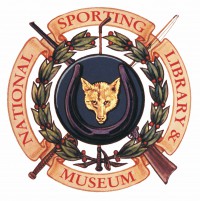For those of us who have never attempted to ride in a sidesaddle, the idea might conjure images of a subdued and dainty rider unchallenged by her environment. For those knowledgeable about the physical ability needed to pursue hunting, however, sidesaddle riding evokes admiration and even awe for the skilled athlete who makes it appear effortless. Sporting artworks beginning with early depictions of women’s forays into the hunting field riding aside (as opposed to astride) on horseback reveal them to be highly trained equestrians fully capable of jumping and galloping alongside men, and sometimes besting them. The artwork spanning over three-hundred years in Sidesaddle, 1690-1935, on view through March 24, 2019, highlights these indomitable women.
The earliest painting in the exhibition is Jan Wyck’s Hare Hunting, c. 1690. Wyck, a Dutch painter, moved to England in the 1660s and became one of the first generation of sporting artists working in the emerging genre. In the painting, the hounds are in full cry on the line of a hare; two gentlemen and a lady follow at a gallop. She is shown relaxed and confident and in full control of her mount.

How to Twist Your Neck, 1809, by Thomas Rowlandson is another great example. The caricature painted in watercolors is a humorous scene showing a lady at a full gallop following a hound. She is bent at the waist having just cleared a low branch. Behind her, her “pursuer” has not ducked and in shocked surprise is about to be dramatically unseated, having run neck-first into the limb.

The painting aptly titled, A Confident Approach, by Henry Thomas Alken, shows an elegant lady foxhunter in a black riding habit and top hat about to take a fence, while the rest of the hunt field goes around, avoiding the jump. She is the only female in the scene, and her muddy skirt is a silent testimony to where she has already been.

The theme continues with Thomas Derville Rowlandon’s set of twelve Foxhunting Scenes. Going to the Meet, The Meet, A Good Start, Going Strong, A Momentary Check, Well Over, A Loose Horse, Hark Away, A Friendly Gate, From Scent to View, With the Leaders, and The Kill follows a lady’s successful day foxhunting on a gray. In Well Over, she jumps a stream with ease while a male hunter has barely cleared the jump and the horse of another has refused. In the next work in the sequence, the second male rider emerges from the stream while another having been unseated, runs after his horse. Each successive composition emphasizes the lady’s skill, often exceeding that of some of her male counterparts, over the course of the day.

In The Meynell – Away from Sutton Cross Roads, after 1920, by Frank Elgernon Stewart, the lady rider is a focal point of the composition in which the huntsman blows his horn and the hounds are in full cry. She is among the leaders of the hunt field following the esteemed hound pack, and she is shown keeping pace with ease, having just cleared a fence.

Each exhilarating work elevates sidesaddle equestrians as they overcame obstacles with skill and panache, riding aside over open country while in skirts. These ladies’ tenacity and grit continue to be celebrated in art to this day.

 Sidesaddle, 1690-1930 was co-curated by Claudia Pfeiffer and Dr. Ulrike Elisabeth Weiss, Lecturer at University of St. Andrews in Scotland and NSLM John H. Daniels Fellow. Pfeiffer has been the George L. Ohrstrom, Jr. Curator of Art at the National Sporting Library & Museum since the position was underwritten by the George L. Ohrstrom, Jr. Foundation in 2012. Her primary focus is the research, design, interpretation, writing, and installation of exhibitions. E-mail Claudia at cpfeiffer@nationalsporting.org
Sidesaddle, 1690-1930 was co-curated by Claudia Pfeiffer and Dr. Ulrike Elisabeth Weiss, Lecturer at University of St. Andrews in Scotland and NSLM John H. Daniels Fellow. Pfeiffer has been the George L. Ohrstrom, Jr. Curator of Art at the National Sporting Library & Museum since the position was underwritten by the George L. Ohrstrom, Jr. Foundation in 2012. Her primary focus is the research, design, interpretation, writing, and installation of exhibitions. E-mail Claudia at cpfeiffer@nationalsporting.org
